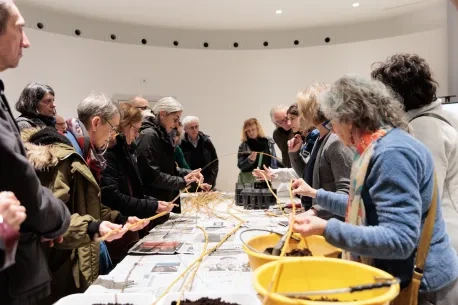Management and monitoring models of local jobs and skills initiatives – Lessons from the Vantaa GSIP Project

This is the web-article No. 9 of the GSIP (Growth and Social Investments Pacts) Project, an initiative of the City of Vantaa (FI) to develop an innovative local jobs and skills agenda. It provides readers with on the ground information about the design and use of management and monitoring models during the implementation of the Project, as documented by the Project Management Team.
1. Introduction
The GSIP Project includes a series of activities aimed at bringing about clearly specified objectives within a defined timeframe and with a specific budget. It reflects two key policy decisions of the City of Vantaa:
- to promote growth and competitiveness of local companies;
- to improve level of education of workforce and offer better training possibilities for low-skilled employees, employees with outdated skills and unemployed persons through the design and implementation of a new, innovative and exceptional service and incentive model (Growth and Social Investments Pacts - GSIPs).
The Project was implemented according to relevant UIA terms and conditions, taking advantage of a sound monitoring system to oversee and follow implementation and to support project management. It has used the Project Cycle Management (PCM) approach, which represents the whole of management activities and decision-making procedures used during its life cycle.
PCM helped Project partners to ensure that all activities were relevant to the agreed strategy (as laid down in the Project application form) and to the problems of selected target groups. It supported to a great extent their adaptation to the COVID-19 challenges, given that the achievement of project objectives is always subject to influences beyond project manager’s direct control (assumptions and risks). It is therefore important to monitor this ‘external’ environment to identify whether or not the assumptions that have already been made are likely to hold true, what new risks may be emerging, and to take action to manage or mitigate these risks where possible
2. The management and monitoring models of the GSIP Project
The City of Vantaa is responsible of the project management through BusinessVantaa, focused on overall management and coordination; consultative evaluation for supporting the Project to follow its objectives, working plans and reach its outputs; and capitalization.
The project management process was elaborated through online discussions during April 2022 with Mirkka Henttonen, the GSIP Project Manager. Mirkka is an expert in Corporate Responsibility, Sustainability & International Development with strong skills in project development and management, reporting, stakeholder liaison and people management.

Weekly project team meetings provided a regular forum for sharing project status within the larger project team. These meetings were complemented by partner meetings (executive committee) that focused on discussing more strategic or management level issues including budget adjustments, the project extension, and the audit process, which then again were further brought to the attention of the Steering Committee when relevant. Additionally, weekly meetings were held between the Project Management Team consisting of the Programme Managers of Vantaa and the academic partners of the GSIP Project (the Metropolia University of Applied Sciences and the Laurea University of Applied Sciences, https://www.uia-initiative.eu/en/news/how-universities-participate-development-local-jobs-and-skills-agendas-lessons-vantaa-gsip-1).

From left to right: Elina Taponen - Metropolia UAS, Mirkka Henttonen - GSIP Vantaa Project Manager and Laura Erkkilä - Laurea UAS.
Participatory development of activities was boosted through co-creation bootcamps targeted for the whole project team, which were complemented by various smaller working groups or task forces.
Effective communication and supportive interaction within the project network were promoted also through a training that paid attention to the special hybrid working context and communication within multi-organization project. This was supported with a live team-building exercises.
The Project Management Team initiated a practice of conducting internal informal training events for its members facilitated by the Project Team members themselves. The idea was to utilize the expertise available within the team to strengthen the capacity of the Project Team in areas that are useful in our daily work, as well as to build the team spirit. The topics of these 2-3-hour training sessions involved themes such video editing, public speaking identification of strengths that each team member possesses.
The GSIP Project has adopted a comprehensive monitoring and evaluation mechanism (M&E) comprising of three complementary components:
a) Impact assessment carried out by the two independent research partners of the GSIP Project, the Research Institute of the Finnish Economy “ETLA” and the Labour Institute for Economic Research PT (https://uia-initiative.eu/en/news/how-could-independent-research-organizations-contribute-development-local-jobs-and-skills)
b) Self-evaluation and analysis conducted by the Project Management Team
c) An external ex-post evaluation, using four pre-defined criteria: relevance, effectiveness, efficiency and impacts as well as to support production of recommendations for continuity, replicability and the scalability of the Project’s results and findings.
Additionally, the steering committee meetings and meetings with the Vantaa leadership have supported the monitoring of the activities and expenditures throughout the Project.
The Project’s internal M&E mechanism ensured monitoring and evaluation of the Project's services through feedback discussions surveys and analysis. The feedback discussions were conducted by the Key Account Managers.
In addition, our research partners, the Research Institute of the Finnish Economy “ETLA” and the Labour Institute for Economic Research PT, have evaluated the effectiveness and impact of the Project using a sound Randomized Controlled Trial (RCT) model. Based on this, the target companies in the Vantaa Region were divided into treatment and control groups and the effectiveness of the Project has been assessed in comparison to the control group.
As a starting point, a comprehensive M&E plan was designed and put into practice during the first implementation phase of the Project (https://uia-initiative.eu/en/news/gsip-expert-journal-1-get-know-project-and-what-happened-first-6-months), given that the initial Project Plan did not include a comprehensive M&E plan that would allow also systematic collection and analysis of qualitative data.
In addition, an account manager system was designed and applied, given that the initial Project Plan did not include any relevant process. This allowed systematic communication with the participating companies and highlighted themes of mutual interest during the Project lifetime.
All Project Partners were involved in management and monitoring processes as the dedicated Project Team. A M&E team consisting of the Programme Managers of Vantaa and the academic partners of the GSIP Project (the Metropolia University of Applied Sciences and the Laurea University of Applied Sciences) was created in September 2020, to implement the M&E plan.
The relevant list includes:
i. Design of the Key Account Manager system (May 2020)
ii. Creation of the Project Management Team (September 2020)
iii. Finalization of the M&E Plan (December 2020)
iv. Implementation of the post-service surveys and feedback discussions (throughout the Project lifetime)
v. Analyzing the data systematically and documenting and sharing the findings through articles and blogs (throughout the Project lifetime)
vi. Publication of the “Competencies for Growth - Collecting and analyzing the lessons learned” Report (March 2022)
vii. Publication of the External Evaluation Report (May 2022).
The Project Management Team performed extremely well and professionally despite the stressful COVID-19 pandemic situation, different organizational cultures and turnover of staff. Efforts were made to maintain high spirits and motivation of the staff through recreational and training activities. We have not been able to avoid having some communication bumps, and the communication training and side activities strengthened our communication and meeting practices positively, contributing to productive and fruitful working atmosphere.
When communication mainly takes place virtually, misunderstandings can occur more easily. We tried to address this through a training, team-building activities and agreeing on common rules and practices for meetings.
a) The Project utilized the unofficial concept of “Asiallista kivaa”- meetings [in English, Factual Fun], where project partners and project workers had the chance to share their know-how and experiences with other project partners. This concept has brought different actors together and created mutual respect between organizations and individual workers.
b) The regular meetings at different levels within the Project Team as well as various workshops and working groups supported smooth cooperation across organizational boundaries. Further, co-creating the services with several organizations supported dissemination of the lessons learned across the organizations providing participating organizations with new perspectives.
c) Creating a shared understanding and working towards common goals over organizational boundaries and inclusion, namely that each member played a role and had a voice, all played a central role in the Project. Mutual interaction and communication were key to the success of the project.
The results of the cooperative network of project partners in the co-creation process are resulted in a creation of local ecosystem of continuous learning. According to the findings of the Project, working in an ecosystem promoted the development of agile solutions and innovations that in this case managed to address companies’ diverse competence needs successfully.
The ecosystem helps ensure continuity of the Project results. The challenge in development projects is their short implementation cycle, which is harmful to the long-term development and implementation of innovations. Cooperation in an ecosystem ensures continuity, proactivity, and reactions to changes in the business environment through continuous dialogue and cooperation.
d) A comprehensive, well-resourced Plan was drafted to ensure the continuity and sustainability of the Project results. This Plan included measures to improve the impact of project services, to scale up the effective service models, and to distribute the results of the project.
e) Systematic communication and thematic publications raised the visibility of the Project’s results and lessons and distributed them for use by other interested stakeholders. The lessons from the Project were compiled in the “New Competencies for Growth” Report. Additionally, a Policy Paper for decision-makers was drafted to pursue a lasting impact.
The Project managers from City of Vantaa and the two UAS formed a tight management team. The co-leadership promoted trust, equality and common understanding between the main project partners, as strategic issues were discussed together, which greatly facilitated consensus-building.
About this resource
The Urban Innovative Actions (UIA) is a European Union initiative that provided funding to urban areas across Europe to test new and unproven solutions to urban challenges. The initiative had a total ERDF budget of €372 million for 2014-2020.
Similar content




